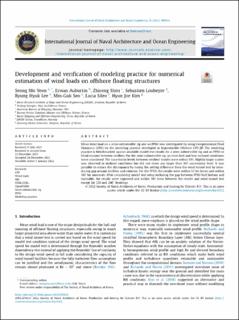| dc.contributor.author | Yeon, Seong Mo | |
| dc.contributor.author | Auburtin, Erwan | |
| dc.contributor.author | Shen, Zhirong | |
| dc.contributor.author | Loubeyre, Sebastien | |
| dc.contributor.author | Lee, Byung Hyuk | |
| dc.contributor.author | Seo, Min-Guk | |
| dc.contributor.author | Sileo, Lucia | |
| dc.contributor.author | Kim, Hyun Joe | |
| dc.date.accessioned | 2022-08-05T10:52:32Z | |
| dc.date.available | 2022-08-05T10:52:32Z | |
| dc.date.created | 2022-04-29T12:42:53Z | |
| dc.date.issued | 2022 | |
| dc.identifier.citation | International Journal of Naval Architecture and Ocean Engineering. 2022, 14 1-13. | en_US |
| dc.identifier.issn | 2092-6782 | |
| dc.identifier.uri | https://hdl.handle.net/11250/3010346 | |
| dc.description.abstract | Mean wind load on a semi-submersible rig and an FPSO was investigated by using Computational Fluid Dynamics (CFD) for the modeling practice developed in Reproducible Offshore CFD JIP. The modeling practice is benchmarked against available model test results for a semi-submersible rig and an FPSO in blind manner between verifiers. For the semi-submersible rig, an even keel and four inclined conditions were considered. The uncertainty levels between verifiers’ results were within 10%. Slightly larger scatter was observed in inclined conditions but did not show any larger than 10% uncertainty level. It was possible to reduce the discrepancy by easing the setting difference from the wind tunnel test by introducing gap around deckbox and columns. For the FPSO, the results were within 3% for forces and within 14% for moments. After considering model test setup including the gap between FPSO hull bottom and turntable, the results were improved and within 10% error between the results and wind tunnel test except for 120 and 240° headings. | en_US |
| dc.language.iso | eng | en_US |
| dc.publisher | Elsevier | en_US |
| dc.rights | Navngivelse 4.0 Internasjonal | * |
| dc.rights.uri | http://creativecommons.org/licenses/by/4.0/deed.no | * |
| dc.subject | Modeling practice | en_US |
| dc.subject | FPSO | en_US |
| dc.subject | Semi-submersible rig | en_US |
| dc.subject | OpenFOAM | en_US |
| dc.subject | STAR-CCM+ | en_US |
| dc.subject | ABL | en_US |
| dc.subject | Wind loads | en_US |
| dc.subject | CFD | en_US |
| dc.title | Development and verification of modeling practice for numerical estimation of wind loads on offshore floating structures | en_US |
| dc.title.alternative | Development and verification of modeling practice for numerical estimation of wind loads on offshore floating structures | en_US |
| dc.type | Peer reviewed | en_US |
| dc.type | Journal article | en_US |
| dc.description.version | publishedVersion | en_US |
| dc.rights.holder | © 2022 Society of Naval Architects of Korea. Production and hosting by Elsevier B.V | en_US |
| dc.source.pagenumber | 1-13 | en_US |
| dc.source.volume | 14 | en_US |
| dc.source.journal | International Journal of Naval Architecture and Ocean Engineering | en_US |
| dc.identifier.doi | 10.1016/j.ijnaoe.2021.100434 | |
| dc.identifier.cristin | 2020114 | |
| dc.source.articlenumber | 100434 | en_US |
| cristin.ispublished | true | |
| cristin.fulltext | original | |
| cristin.qualitycode | 1 | |

